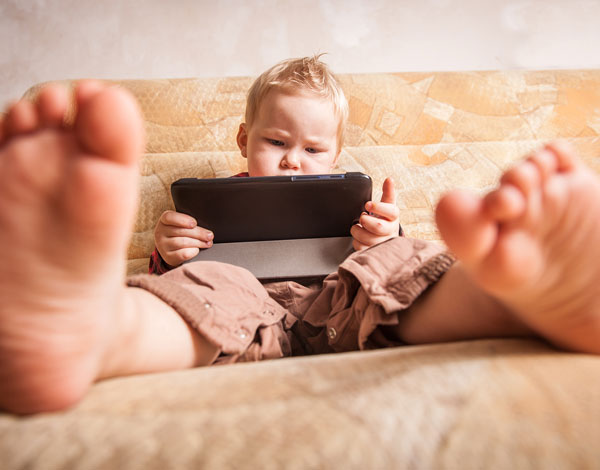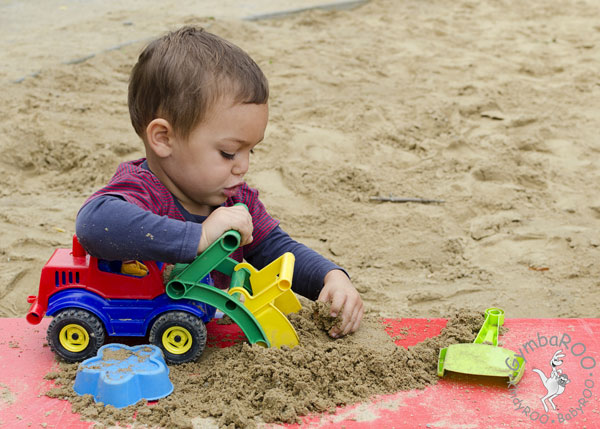Join the thousands of parents already raising smarter, happier babies with our online baby classes: The Active Babies Smart Kids series. Click here.
GymbaROO-KindyROO kids are excelling academically, emotionally, in leadership roles and on the sporting field. Find us at: GymbaROO-KindyROO
Bindy Cummings and Jane Andrew
Screen time is here to stay and for children under the age of five years is rising at an alarming rate. Screens, in their multitude of forms, will be a part of your children’s lives at some point. What parents really need to be on top of is; the latest research findings, what experts are recommending and alternative ways to engage babies and children without screens.
The research
Researchers are finding that screens are not always a bad thing and there are some benefits to letting little ones use technology. Some educational apps and TV shows can promote brain development however, there’s a line, and cross it and parents may actually unintentionally be doing significantly more harm than good. Most of the essential stimuli needed for child development in the early years is not found on today’s tablet screens. When a young child spends too much time in front of a screen and not getting enough required stimuli from the real world, development can become stunted.1 A number of troubling studies have connected delayed cognitive development in children with extended exposure to electronic media. Dr. Aric Sigman, an associate fellow of the British Psychological Society and a Fellow of Britain’s Royal Society of Medicine, says getting hooked on tablets and smartphones can cause permanent damage to the still-developing brains of very small children. Too much screen time too soon, he says, “is the very thing impeding the development of the abilities that parents are so eager to foster through the tablets. The ability to focus, to concentrate, to lend attention, to sense other people’s attitudes and communicate with them, to build a large vocabulary—all those abilities are harmed.”1 The long term development and health implications are real.
A number of troubling studies have connected delayed cognitive development in children with extended exposure to electronic media. Dr. Aric Sigman, an associate fellow of the British Psychological Society and a Fellow of Britain’s Royal Society of Medicine, says getting hooked on tablets and smartphones can cause permanent damage to the still-developing brains of very small children. Too much screen time too soon, he says, “is the very thing impeding the development of the abilities that parents are so eager to foster through the tablets. The ability to focus, to concentrate, to lend attention, to sense other people’s attitudes and communicate with them, to build a large vocabulary—all those abilities are harmed.”1 The long term development and health implications are real.
Caution: Children not at play
Between birth and age three is a critical period for learning. Paediatric associations in the US, UK, Canada and Australia and GymbaROO’s own research, reminds parents that children experience unparalleled physical, mental and emotional growth in the earliest years of life and it is during this time that the foundations for all later learning and ability are laid.

Throughout childhood, the active child is building essential motor-sensory pathways in the brain through physical movement and sense experiences. Movement, repetition and rhythmical activities stimulate growth along nerve pathways that will later be used for academics, coordination, transporting perceptions, memories, feelings and thoughts.
Passive activities experienced through TVs, videos, computers, tablets, game-stations and hand-held devices, slow down physical and neurological development and limit sensory integration. Time spent watching digital media is time taken away from activities that nurture growth and healthy development. Children exposed to high levels of daily screen-time are likely to have shorter attention spans, an inability to concentrate, a sensory system that may become hypo or hyper sensitive, under developed fine and gross motor skills and poor social skills/emotional regulation. Research is showing that ‘screen dominated’ children are disconnecting from society. These children risk developing their identity from games played and shows watched on the screen rather than from everyday interactions with children their own age and their families.
Children exposed to high levels of daily screen-time are likely to have shorter attention spans, an inability to concentrate, a sensory system that may become hypo or hyper sensitive, under developed fine and gross motor skills and poor social skills/emotional regulation. Research is showing that ‘screen dominated’ children are disconnecting from society. These children risk developing their identity from games played and shows watched on the screen rather than from everyday interactions with children their own age and their families.
Liraz Margalit Ph.D in her article: What Screen Time Can Really Do to Kids’ Brains explains further:
“Much of the issue lies with the fact that what makes tablets and iPhones so great—dozens of stimuli at your fingertips, and the ability to process multiple actions simultaneously—is exactly what young brains do not need.
“Tablets are the ultimate shortcut tools: Unlike a mother reading a story to a child, for example, a smartphone-told story spoon-feeds images, words, and pictures all at once to a young reader. Rather than having to take the time to process a mother’s voice into words, visualise complete pictures and exert a mental effort to follow a story line, kids who follow stories on their smartphones get lazy. The device does the thinking for them, and as a result, their own cognitive muscles remain weak.”
Trouble making friends
Margalit continues: “The brain’s frontal lobe is the area responsible for decoding and comprehending social interactions. It is in this corner of the mind that we empathise with others, take in nonverbal cues while talking to friends and colleagues, and learn how to read the hundreds of unspoken signs—facial expression, tone of voice, and more—that add colour and depth to real-world relationships.
“So how and when does the brain’s frontal lobe develop? Not surprisingly, the most crucial stage is in early childhood, during that same critical period, and it’s dependent on authentic human interactions. So if your young child is spending all of his time in front of an iPad instead of chatting and playing with teachers and other children, his empathetic abilities—the near-instinctive way you and I can read situations and get a feel for other people—will be dulled, possibly for good.
Life has no on/off switch
“Have you ever seen a mother chuckle as her baby tries to “swipe” a real photograph, or punch their fingers onto a poster or book as if it were a touchscreen? It may seem cute, but it points to something much deeper in the child’s brain—an internalisation that all actions have an immediate effect, and all stimuli elicit a quick response.
“This is true in the on-screen world, but nowhere else. When every finger swipe brings about a response of colours and shapes and sounds, a child’s brain responds gleefully with the neurotransmitter dopamine, the key component in our reward system that is associated with feelings of pleasure. Dopamine hits in the brain can feel almost addictive, and when a child gets too used to an immediate stimuli response, he will learn to always prefer smartphone-style interaction—that is, immediate gratification and response—over real-world connection. This pattern mimics, in a less intense manner, the dangerous cycle psychologists and physicians regularly see in patients with drug and alcohol addictions.”1
Nicholas Kardaras, addictions expert and author of Glow Kids: How Screen Addiction Is Hijacking Our Kids warns: “We’re now getting brain imaging research that shows that screen time affects the frontal cortex the exact same way as cocaine addiction…There are over two hundred studies that correlate excessive screen usage to everything from ADHS effects, obesity, anxiety, depression and even psychotic like symptoms.” 2
What the experts are recommending: Screen time guidelines
The guidelines from the American Academy of Pediatrics (AAP) suggest that:
- Children under 18 months should avoid screen time, other than video-chatting.
- Children aged 18 months to 2 years can watch or use high-quality programs or apps if adults watch or play with them to help them understand what they’re seeing.
- Children aged 2-5 years should have no more than one hour a day of screen time with adults watching or playing with them.
- Children aged 6 years and older should have consistent limits on the time they spend on electronic media and the types of media they use.
Other experts 3
- The Canadian Pediatric Society discourages screen-based activities for children under two.
- Addictions expert Nicholas Kardaras said parents should wait until kids are at least ten years old to expose them to portable screen time.
What’s the alternative? Ways to create PLAY
Screen should be used in moderation and never stand in for human interaction. If screen-time has taken over your child’s play, act now to find a balance and promote self-initiated play and real life activities for a healthy brain and body. Working towards balancing screen-time with play activities that engage the whole body will help balance their development and improve their capacity for learning and living. Power off regularly and help your child establish clear boundaries between the real world and a virtual one. Children between the ages of two and five years should have at least three to four hours of active play every day.
Sensory play—awakens and integrates the sense system which leads to greater physical awareness and capacity. Play-dough, buckets and hoses for water play and sand pits are some good examples. Exploratory play— this gives children valuable information about the world around them and helps them learn to co-ordinate their body movements. Children can use anything with which they can interact – it does not have to be expensive or fancy! Open a cupboard and let them play with the pots ‘n pans, wooden spoons and cooking trays. What can they do with it all? Build a tower? Start a band? Make an obstacle course to drive little cars over, around, under? The ideas are only limited by their imagination… but you may need to be on hand to get the ideas flowing.
Exploratory play— this gives children valuable information about the world around them and helps them learn to co-ordinate their body movements. Children can use anything with which they can interact – it does not have to be expensive or fancy! Open a cupboard and let them play with the pots ‘n pans, wooden spoons and cooking trays. What can they do with it all? Build a tower? Start a band? Make an obstacle course to drive little cars over, around, under? The ideas are only limited by their imagination… but you may need to be on hand to get the ideas flowing.
Role play—when children imitate the world around them, playing out real life activities. Places like cubby houses and providing smaller versions of household tools helps create opportunities for this.

Social play—when children reach out to connect with others they rehearse turn taking, negotiation and getting along. Setting up play-dates at home or going out to a playground are a great start.

Rough and tumble play — in addition to building strength and co-ordination, this type of play guides aspects of character development like trust, risk-taking and discovering personal boundaries. Use old mattresses for wrestling matches or obstacle courses, encourage tree climbing and games/activities that invite lifting, pulling and pushing.

Bindy Cummings is a teacher, GymbaROO early childhood neurodevelopmental consultant and early childhood development lecturer. She is the Editor of GymbaROO’s ‘First Steps’ magazine. More on Bindy Cummings here.
Jane Andrew is a Teacher and Extra Lesson Practitioner. She is passionate about helping parents understand the impact excessive digital media exposure can have on the developing child.
GymbaROO Images by Studio Z Photography
Resources: 1. Liraz Margalit Ph.D. https://www.psychologytoday.com/blog/behind-online-behavior/201604/what-screen-time-can-really-do-kids-brains2. http://winnipeg.ctvnews.ca/warnings-about-the-dangers-of-excessive-screen-time-on-children-s-brains-development-1.32893093.https://www.aap.org/en-us/about-the-aap/aap-press-room/pages/american-academy-of-pediatrics-announces-new-recommendations-for-childrens-media-use.aspx 4.http://activebabiessmartkids.com.au/articles/screen-time-effects-child-development/
GymbaROO-KindyROO
Thousands of parents, babies and children are presently involved in our programs and creating rising stars. GymbaROO-KindyROO kids are excelling academically, emotionally, in leadership roles and on the sporting field. Come join all the fun and learning! “GymbaROO – The best decision I ever made for my child.” Classes from 6 weeks old – 7 years GymbaROO KindyROO
Active Babies Smart Kids – Online Baby Classes
GymbaROO-KindyROO’s online series of baby classes is taking the parenting world by storm! It is highly recommended by doctors, paediatricians, early childhood experts and the Maternal Child and Family Health Nurses Association. This series is being called: “The essential guide for parents”. Join the thousands of parents already playing with their babies from birth, in the best way for brain and body development and laying crucial foundations for future learning. What happens in the first year, not only matters, it matters a lot!
Active Babies Smart Kids online series – Click here.
Try the first class FREE! Click here to watch our Active Babies Smart Kids Episode 1 – Tummy Time
Enjoy the following GymbaROO-KindyROO articles
GymbaROO-KindyROO: Who, what, where, why and how
All about GymbaROO-KindyROO’s online baby classes for parents and babies: Active Babies Smart Kids
How to raise a smarter, happier baby
Why every young child needs a trapeze and how to make one.
Trampolines – The benefits of the bounce for babies and children.
He May Not ‘Grow Out of It’. A Checklist for Parents of 0 – 5 Year Olds.
Choosing childcare that fosters neuro-development, quality play and rich learning environments.
Baby Development Classes. Why GymbaROO for Babies?
Why creeping and crawling matter.
Click here for more GymbaROO-KindyROO article choices


